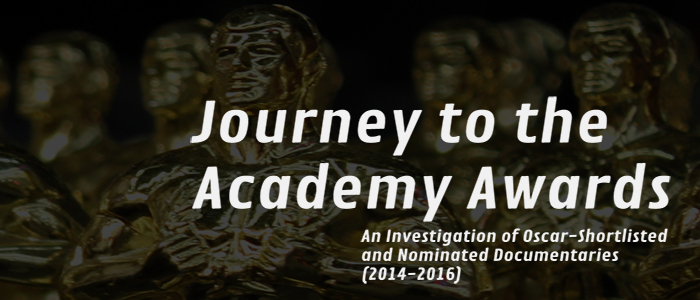
For a documentary filmmaker, being recognized by the Academy of Motion Picture Arts & Sciences for an Oscar nomination in the Best Documentary Feature category is often the pinnacle moment in a career. What does it take for a documentary film and its director and producer to make it to the top—the Oscars shortlist, the nomination and the win? Which film directors are recognized—in terms of race and gender? Are the shortlisted films’ stories focused on pressing social issues, or slice-of-life entertainment stories? Where can audiences see the documentaries—on PBS, HBO, iTunes, Netflix or somewhere else? How are the top documentary films distributed—by major studio distributors or smaller independent companies? What other kinds of awards can predict —or are associated with—Oscar recognition, if any? This study aimed to answer these questions through a systematic examination of the last three years (2014, 2015 and 2016) of Academy Award-shortlisted, -nominated and -winning documentary films—a total of 45 films and 56 credited directors.
By Caty Borum Chattoo, Co-Director, Center for Media & Social Impact
American University School of Communication | Washington, D.C.
February 2016
PRELIMINARY KEY FINDINGS
Download PDF here.
Overview
For a documentary filmmaker, being recognized by the Academy of Motion Picture Arts & Sciences for an Oscar nomination in the Best Documentary Feature category is often the pinnacle moment in a career. Beyond the celebratory achievement, the acknowledgment can open up doors for funding and opportunities for next films and career opportunities. The formal recognition happens in three phases: It begins in December with the Academy’s announcement of a shortlist—15 films that advance to a formal nomination for the Academy’s Best Documentary Feature Award. Then, in mid-January, the final list of five official nominations is announced. Finally, at the end of February each year, the one winner is announced at the Academy Awards ceremony. Beyond a film’s narrative and technical prowess, the marketing campaigns that help a documentary make it to the shortlist and then the final nomination list are increasingly expensive and insular, from advertisements in entertainment trade outlets to lavish events to build buzz among Academy members and industry influencers.
What does it take for a documentary film and its director and producer to make it to the top—the Oscars shortlist, the nomination and the win? Which film directors are recognized—in terms of race and gender? Are the shortlisted films’ stories focused on pressing social issues, or slice-of-life entertainment stories? Where can audiences see the documentaries—on PBS, HBO, iTunes, Netflix or somewhere else? How are the top documentary films distributed—by major studio distributors or smaller independent companies? What other kinds of awards can predict —or are associated with—Oscar recognition, if any?
This study aimed to answer these questions through a systematic examination of the last three years (2014, 2015 and 2016) of Academy Award-shortlisted, -nominated and -winning documentary films—a total of 45 films and 56 credited directors. From this close investigation of Oscar-shortlisted documentary films, consistent patterns emerge to paint a portrait of documentary films and directors at this highest level of achievement.
Highlights
RACE: Oscar shortlist recognition consistently favors white documentary directors.
Despite the increasing participation and recognition of documentary directors of color at major film festivals, documentary directors recognized by the Academy Awards shortlist and nomination process are overwhelmingly white. In fact, almost nine in 10 (89 percent) of the 56 recognized Oscar-shortlisted documentary directors over the past three years are white. In 2015, all 17 shortlisted directors were white. [See “Methodology.”]
GENDER: Recognition of female documentary directors remains consistently rare.
Despite admirable funding and development initiatives to widen the playing field for female documentary directors at the highest level, the documentaries that are recognized with pinnacle-career Academy Award shortlist and nomination recognitions are primarily directed by men. The trend over the past three years shows almost no change. Across 56 directors over three years (2014-2016), 77 percent on the Oscar shortlist were men, and 23 percent were women.
TOPICS: Pressing social issues are likely to be shortlisted for Oscar recognition.
Consistently, documentaries that work at the intersection of investigative journalism and film —addressing pressing social issues and perhaps impacting them — are recognized by the Academy in the shortlist process. Across three years, more than half (56 percent) of the recognized films focused on pressing social issue investigations (from animal welfare to sexual assault to genocide to government surveillance), compared to 44 percent that focused on “slice of life” narratives. Across the final 15 Oscar-nominated films over the three years, nine were focused on pressing current social issue investigations (for example, the 2015 Oscar-winning documentary CitizenFour), and six were slice-of-life narratives (for example, the 2014 Oscar-winning documentary 20 Feet from Stardom).
AWARDS: The connection between Cinema Eye Honors to Academy Award is strong.
Film festivals are crucial to these top filmmakers not only because of the exposure to audiences, critics, media and distributors, but because of their connection to major awards. The major entertainment industry awards—from the Directors Guild of America (DGA), Writers Guild of America (WGA) and others—aren’t connected to the Academy-shortlisted and nominated films as much as other awards unique to documentaries. Across all films, the most consistent connection to an Academy Award recognition is the Cinema Eye Honors, launched in 2007. The Cinema Eye Honors, which kick off the year each January, recognize the best in nonfiction filmmaking from the previous year, and nominations are gleaned solely through representatives of major film festivals that showcase documentary work (including the Sundance Film Festival, AFI DOCS, True/False, Sheffield Doc/Fest, Full Frame, Hot Docs and others). In terms of award success, following Cinema Eye recognition (29 percent of shortlisted films were awarded), Academy-shortlisted films are most likely to win Sundance Film Festival (16 percent) and International Documentary Association (IDA) awards (13 percent). (In this way, the “awards season” for documentary films at the highest level lasts more than a year – the initial bookend begins in January at the Sundance Film Festival, then continues through the IDA Awards (December) and the Cinema Eye Honors the following January, along with the various guilds’ awards for several months prior to the Oscars – with many film festival awards in between.)
DISTRIBUTION: Film festivals and online streaming platforms dominate Oscar-shortlisted and nominated films’ distribution plans.
The Oscar-shortlisted documentary teams are making the rounds of film festivals and making sure audiences can see their work via online streaming platforms. TV is still important, but perhaps not as important as – or perhaps more elusive as distribution deals than – online streaming platforms for audience discovery and buzz. The emergent distribution power player over the past few years is Netflix, which distributed at least one Best Documentary Feature documentary in each year studied, and two this year (What Happened, Miss Simone? and Winter on Fire: Ukraine’s Fight for Freedom).
Preliminary Key Findings
Directors: Race & Gender
The overwhelming majority of credited Oscar-shortlisted documentary film directors are white and male, and the ratio has remained relatively unchanged over the past three years across 56 credited directors recognized in 45 total films. Notably, in one year – 2015 – no documentary directors of color were recognized at all, even on the Oscar shortlist. In the most recent year, 2016, 82 percent of shortlist-recognized documentary film directors are white (18 percent are non-white), and 82 percent are male (18 percent are female).When we take into account race and gender combined, the portrait looks like this for Oscar-shortlisted documentary directors over the past three years: 71 percent are white men, 18 percent are white women, and equal proportions (about 5 percent each) men and women of color.
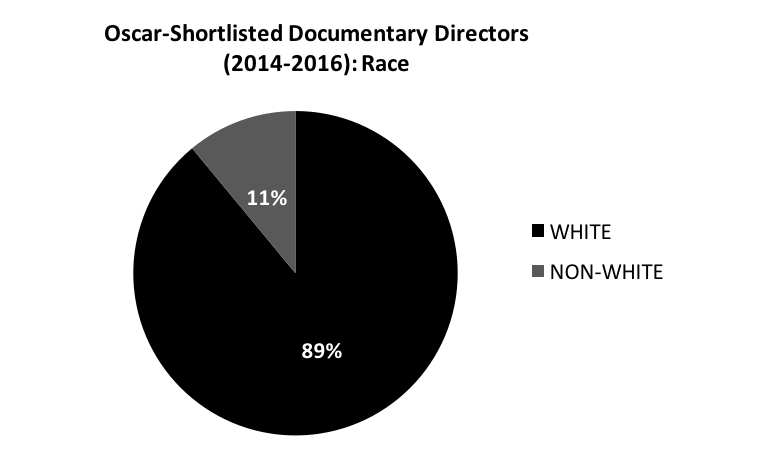
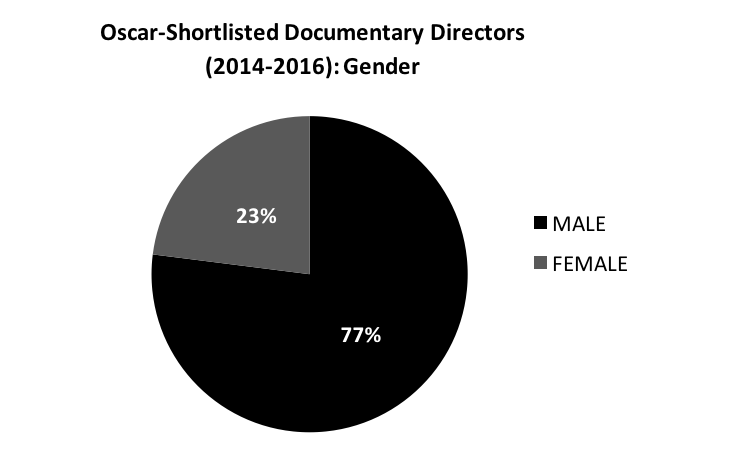

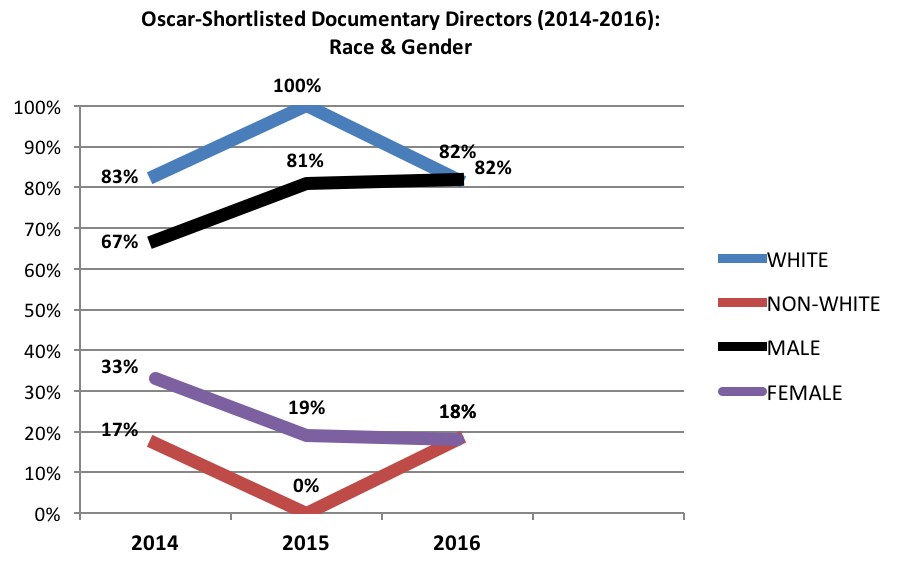
The Official Oscar Nominees (2014-2016): Race & Gender
Of the 18 final nominee directors for Best Documentary Feature from 2014 to 2016 (15 total nominated films), 83 percent are white and 17 percent are directors of color. Almost three-quarters (72 percent) are male and 28 percent are female. This year (2016), four of the five nominated directors are white, and four of the five are male.

Topics: Investigating Social Issues vs. Slice-of-Life Stories
More than half of the documentary films recognized by the Academy Awards shortlist are serious investigations of pressing social issues, ranging from sexual assault on college campuses to drug violence to genocide and oppression of girls around the world. The ratio has remained relatively consistent from one year to the next. About 56 percent of recognized films fall into the “serious social issue investigation and awareness” category of storytelling, compared to about 44 percent that are entertainment stories – “slice of life” narratives – unrelated to pressing social issues. (Examples of films dealing with pressing social issues include Blackfish, Virunga andCitizenFour, and examples of entertaining slice-of-life narratives include Best of Enemies, 20 Feet from Stardom and Life Itself.)
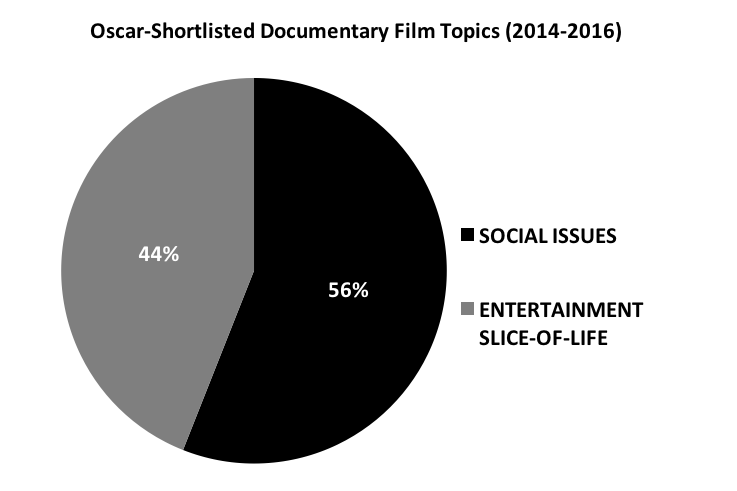
The Official Oscar Nominees (2014-2016): Topics
Of the 15 final nominee films for Best Documentary Feature across all three years, 9 have core narratives that focus on social issue investigations, while six are slice-of-life stories.
The Official Oscar Nominees (2016 Only): Topics
This year, three of the five nominated films’ narratives focus primarily on social issues, while two are biopics (Amy, produced by On the Corner Films; and What Happened, Miss Simone?, produced by RadicalMedia and Moxie Firecracker). Cartel Land, produced by Our Time Projects and The Documentary Group, focused on drug trafficking and drug wars; The Look of Silence, produced by Final Cut for Real, focused on the aftermath of the Indonesian genocide in the mid-1960s; andWinter on Fire: Ukraine’s Fight for Freedom, produced by Pray for Ukraine Productions, focused on the Ukrainian revolution.
Distribution: Streaming + Film Festivals + TV
Most of the documentary films shortlisted over the past three years employed a multi-tiered distribution strategy, including the film festival circuit, TV broadcast and streaming; a theatrical screening is required for an Academy Award shortlist and nomination, so all of the films completed some limited or extensive theatrical runs. Only a few films didn’t complete all three distributions levels (festivals, streaming, TV) in their road to Oscar, given the importance of audience (and Academy) awareness and buzz around the films. (Although alternative distribution was not a systematic element included in this particular study, it’s worth mentioning the fact that many documentary films also pursue community/grassroots and educational screenings. Additionally, the shortlisted films screen at industry events, including screenings for the Academy of Motion Picture Arts & Sciences, the entertainment industry guilds, the International Documentary Association screening series and others.)
Across all forms of distribution – including theatrical, film festivals, TV and streaming – online streaming has increased as an important platform for sustaining buzz and audience engagement. Almost 9 in 10 (89%) Oscar-shortlisted documentary filmmakers choose online streaming platforms – and many of the films are distributed across several at once or in succession – as major distribution mechanisms for their films in order to gain critical audience awareness and media coverage. Of the four popular streaming outlets – Amazon, iTunes, YouTube, Netflix – Amazon and iTunes remain the most dominant as a way to watch high-caliber Oscar-recognized documentary films. However, Netflix, as both a distributor and a subscription video demand (SVOD) platform, sits in an increasingly important power position, enabling audiences to access high-caliber documentary films.
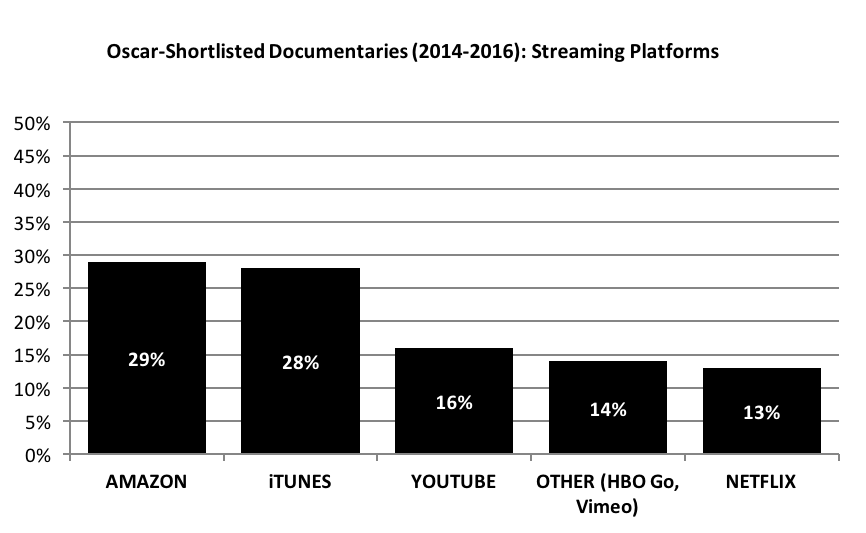
Television is still an important distribution platform for high-level documentary films. Across all three years, 67 percent of shortlisted films were broadcast on TV. (Note: To look at time-trend data or final totals, it’s too early to make final determinations about changes over time between the major distribution mechanisms, given that many of the 2016 shortlisted and nominated films are still in the early or mid-level phases of their films’ life cycles, which means TV and streaming windows may still be to come. We plan to review the data and distribute final findings later in 2016 after the most recent films have maximized their final distribution opportunities.)
In terms of the specific TV networks that matter most to propelling a documentary onto the Academy Award shortlist and nomination, across the average of the past three years, HBO is the dominant network, followed by a composite of other cable networks (Showtime, Starz, Pivot, National Geographic). PBS comes in third place, followed by CNN Films. With regard to a trend over the past several years, it’s sporadic at best, although several TV outlets consistently rise to the top. HBO dominates all three years, CNN Films may be on the increase, and other cable networks (National Geographic, Showtime) also show up (in the “other” category). (Again, a cautionary note is in order for 2016 films and examining a full time trend and totals yet, as many 2016 shortlisted and nominated films may pursue TV distribution sometime later this year, given where they are in the full life cycles of the films.)
Distribution Companies
Over the past three years, Oscar-shortlisted and nominated films were distributed by a handful of distribution companies, but the major film studios’ independent arms and a few relatively new players rise to the top. While no one company has distributed more than seven of the 45 shortlisted films over three years, it’s worth examining HBO, with seven films, and Radius-TWC, the Weinstein independent distribution arm founded in 2012, in particular. Not only did Radius-TWC distribute four of the shortlisted films, but three of the four made it to final Oscar nomination, and two won Best Documentary Feature (20 Feet From Stardom in 2014, and CitizenFour in 2015). None of the consistent distribution companies can make this claim (but Sony Pictures Classics, with four films on the full shortlist across three years, distributed one film that was formally nominated). Other important documentary distribution companies include Magnolia Pictures and Drafthouse Pictures.
Awards Connected to Oscar
The one award that is consistently the best connection to an Oscar shortlist recognition for documentary films is the relatively new Cinema Eye Honors, followed by awards given at the Sundance Film Festival, and the IDA Documentary Awards. Despite their prominence in the entertainment business, the major industry awards—Directors Guild of America (DGA), Writers Guild of America (WGA), Producers Guild of America (WGA)—generally don’t register as prominently for the majority of Oscar-shortlisted and nominated films. (The notable exception is the 2015 Oscar winner in the Best Documentary Feature category, CitizenFour, which won almost all of these awards, plus additional journalism awards.) Most of the shortlisted and nominated documentary filmmakers win many awards in the national and international film festival circuit, much more so than the ones sponsored by the entertainment guilds (i.e., DGA, WGA, PGA).
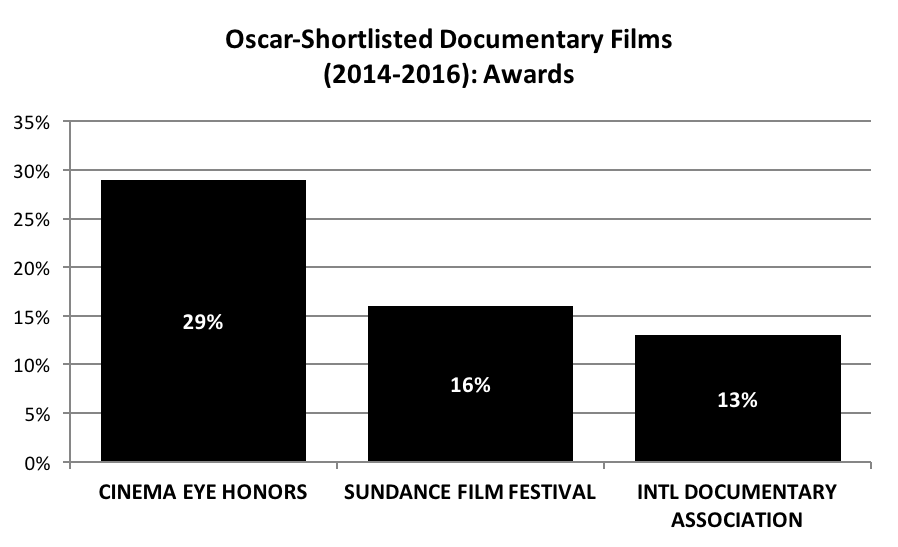
Studied Films: 2014-2016
Films Shortlisted for the 2014 Academy Awards
The Act of Killing, Final Cut for Real; Dir.: Joshua Oppenheimer; Drafthouse Pictures (Nominated: Best Documentary Feature, 2014)
The Armstrong Lie, The Kennedy/Marshall Company; Dir.: Alex Gibney; Sony Pictures Classics
Blackfish, Our Turn Productions; Dir.: Gabriella Cowperthwaite; Magnolia Pictures
The Crash Reel, KP Rides Again; Dir.: Lucy Walker; HBO Documentary Films/Phase 4 Films
Cutie and the Boxer, Ex Lion Tamer and Cine Mosaic; Dir.: Zachary Heinzerling; Radius-TWC (Nominated: Best Documentary Feature, 2014)
Dirty Wars, Civic Bakery; Dir.: Richard Rowley; Sundance Selects; (Nominated: Best Documentary Feature, 2014)
First Cousin Once Removed, Experiments in Time, Light & Motion; Dir.: Alan Berliner; HBO Documentary Films
God Loves Uganda, Full Credit Productions; Dir.: Roger Ross Williams; Variance Films
Life According to Sam, Fine Films; Dirs.: Sean Fine, Andrea Nix Fine; HBO Documentary Films
Pussy Riot: A Punk Prayer, Roast Beef Productions; Dirs.: Maxim Pozdorovkin, Mike Lerner; HBO Documentary Films
The Square, Noujaim Films and Maktube Productions; Dir.: Jehane Noujaim; Netflix (Nominated: Best Documentary Feature, 2014)
Stories We Tell, National Film Board of Canada; Dir.: Sarah Polley; Roadside Attractions
Tim’s Vermeer, High Delft Pictures; Dir.: Teller; Sony Pictures Classics
20 Feet from Stardom, Gil Friesen Productions and Tremolo Productions; Dir.: Morgan Neville; Radius-TWC (Winner: Best Documentary Feature, 2014)
Which Way Is the Front Line from Here? The Life and Time of Tim Hetherington, Tripoli Street; Dir.: Sebastian Junger; HBO Documentary Films
Films Shortlisted for the 2015 Academy Awards
The Case against 8, Day in Court; Dirs.: Ben Cottner, Ryan White; HBO Documentary Films
Citizen Koch, Elsewhere Films; Dirs.: Carl Deal, Tia Lessin; self-distributed
CitizenFour, Praxis Films; Dir.: Laura Poitras; Radius-TWC (Winner: Best Documentary Feature, 2015)
Finding Vivian Maier, Ravine Pictures; Dirs.: John Maloof, Charlie Siskel; IFC Films (Nominated: Best Documentary Feature, 2015)
The Internet’s Own Boy, Luminant Media; Dir.: Brian Knappenberger; Participant Media/Film Buff
Jodorowsky’s Dune, City Film; Dir.: Frank Pavich; Sony Pictures Classics
Keep On Keepin’ On, Absolute Clay Productions; Dir.: Alan Hicks; Radius-TWC
The Kill Team, f/8 filmworks; Dir.: Dan Krauss; Oscilloscope Laboratories
Last Days in Vietnam, Moxie Firecracker Films; Dir.: Rory Kennedy; American Experience Films/PBS (Nominated: Best Documentary Feature, 2015)
Life Itself, Kartemquin Films and Film Rites; Dir.: Steve James; Magnolia Pictures
The Overnighters, Mile End Films West; Dir.: Jesse Moss; Drafthouse Pictures
The Salt of the Earth, Decia Films; Dir.: Wim Wenders; Sony Pictures Classics (Nominated: Best Documentary Feature, 2015)
Tales of the Grim Sleeper, Lafayette Film; Dir.: Nick Broomfield; HBO Documentary Films
Virunga, Grain Media; Dir.: Orlando von Einsiedel; Netflix (Nominated: Best Documentary Feature, 2015)
Films Shortlisted for the 2016 Academy Awards
Amy, On the Corner Films; Dir.: Asif Kapadia; A24 (Nominated: Best Documentary Feature, 2016)
Best of Enemies, Tremolo Productions and Media Ranch; Dirs.: Morgan Neville, Robert Gordon; Magnolia Pictures/Participant Media
Cartel Land, Our Time Projects and The Documentary Group; Dir.: Matthew Heineman; The Orchard (Nominated: Best Documentary Feature, 2016)
Going Clear: Scientology and the Prison of Belief, Jigsaw Productions; Dir.: Alex Gibney; HBO Documentary Films
He Named Me Malala, Parkes-MacDonald and Little Room; Dir.: Davis Guggenehim; Fox Searchlight
Heart of a Dog, Canal Street Communications; Dir.: Laurie Anderson; Abramarama
The Hunting Ground, Chain Camera Pictures; Dir.: Kirby Dick; Radius-TWC
Listen to Me Marlon, Passion Pictures; Dir.: Stevan Riley; Universal/Showtime
The Look of Silence, Final Cut for Real; Dir.: Joshua Oppenheimer; Drafthouse Pictures (Nominated: Best Documentary Feature, 2016)
Meru, Little Monster Films; Dirs.: Jimmy Chin, Elizabeth Chair Vasarhelyi; Music Box Films
3 1/2 Minutes, 10 Bullets, Motto Pictures, Lakehouse Films, and Actual Film; Dir.: Marc Silver; Participant Media
We Come as Friends, Adelante Films and KGP – Kranzelbinder Gabriele Production; Dir.: Hubert Sauper; sellf-distributed
What Happened, Miss Simone?, RadicalMedia and Moxie Firecracker; Dir.: Liz Garbus; Netflix (Nominated: Best Documentary Feature, 2016)
Where to Invade Next, Dog Eat Dog Films and IMG Films; Dir.: Michael Moore
Winter on Fire: Ukraine’s Fight for Freedom, Pray
Methodology
This key findings document represents the preliminary findings of a larger study to be released later in 2016. Directed by Caty Borum Chattoo, co-director of the Center for Media & Social Impact, a small team of researchers systematically gathered, archived and fact-checked data for 45 total films across three years (2014, 2015 and 2016) along the road to the Academy Award. Data gathering took place from October 2015 through February 2016. The examined films were all shortlisted for the Academy Award in November of the preceding year (15 each per year), with five progressing each year – the following January or February after the shortlist announcement – to the formal Oscar nomination for Best Documentary Feature Film. Each film was then categorized and coded according to key areas of interest in which data could be comprehensively and accurately gathered and confirmed via publicly-available information: Credited directors’ broad racial (white or non-white) and gender (male or female) categories; film topic areas (social-issues dominated or slice-of-life entertainment narratives); distribution details across festivals, TV and streaming platforms; and awards. The team additionally looked at sources of funding for all films, but given that much of this data is not reliably and consistently publicly available for all films, these results are not included in the key findings. With regard to distribution mechanisms – streaming, festivals, TV – a cautionary note is in order for 2016 films and the ability to make full averaged conclusions across the three studied years about year-to-year trends and totals yet, as many 2016 shortlisted and nominated films may pursue TV and streaming distribution sometime later this year, given where they are in the full life cycles of the films.
Across all three waves of shortlisted documentary films (45 total films), a total of 56 filmmakers were formally credited as directors, given that some films credited more than one director; all directors were coded for this analysis, including any instances in which a director was credited as a “co-director.” Individuals included in producer credits were not coded here, but they may be added in future additional analysis. Data was collected using a cross-referenced combination of the official film websites, IMDB profiles, and media coverage about each film and filmmaker during the period from shortlist to nomination to Academy Awards. Best efforts were made to verify each available data point through multiple sources of public information. With regard to race: For this analysis, only “white” and “non-white” were coded, given the limitations of using visual and media data (photos, IMDB profiles, media articles) alone. The specific racial identifications of film directors – beyond broad categories of white and non-white – were not determined given the potential challenges in visual identifications (cross-referenced with media articles as needed). American University graduate students Nesima Aberra (American University’s International Media graduate program) and Hannah Sedgwick (American University’s Strategic Communication graduate program) contributed data gathering and data coding.
